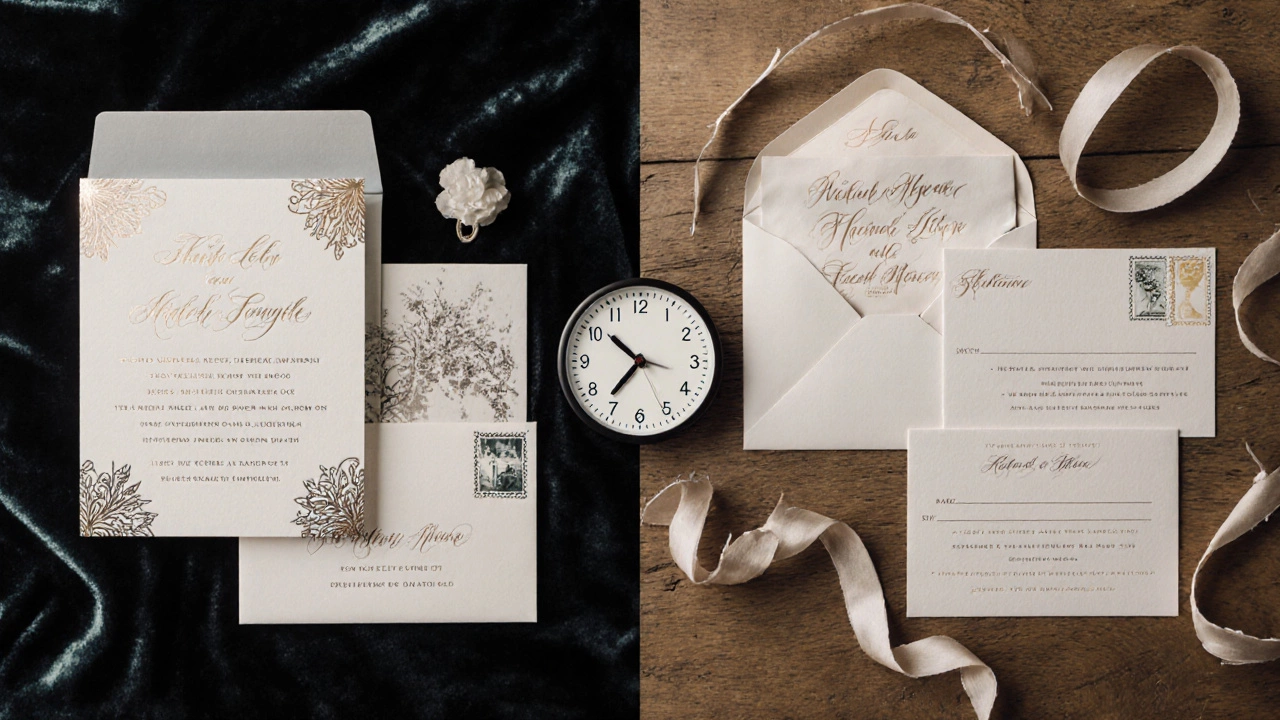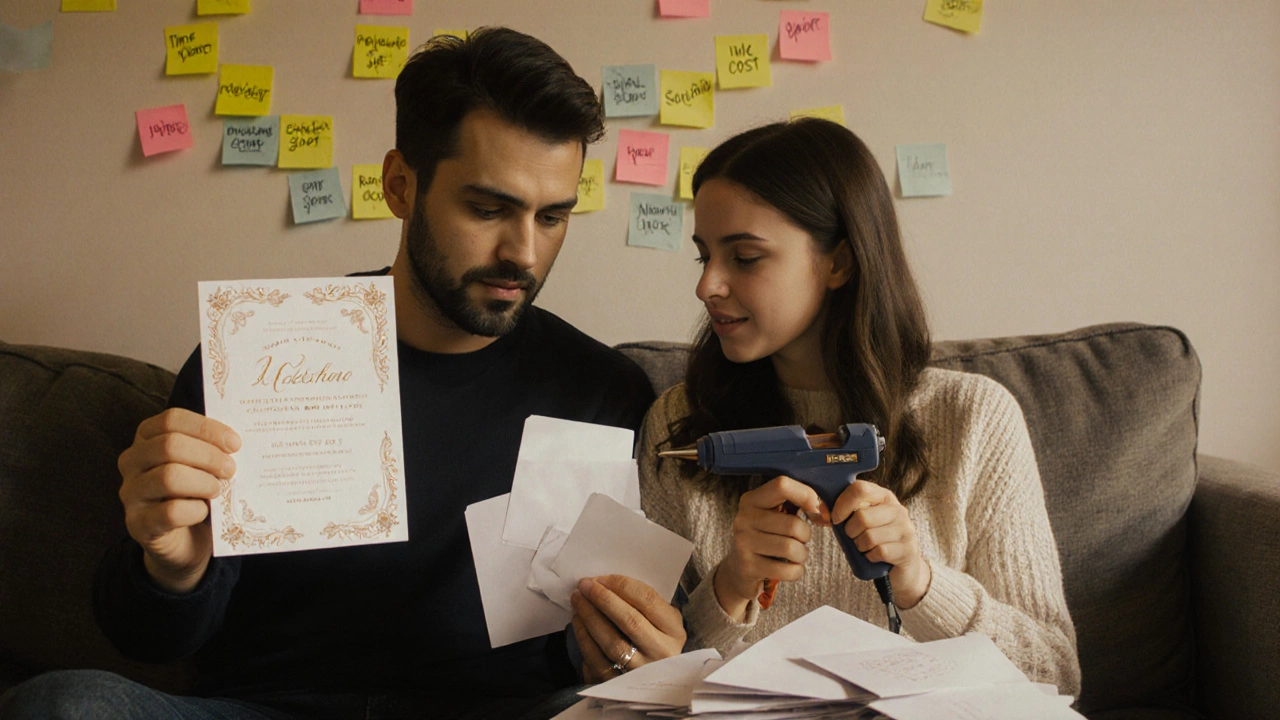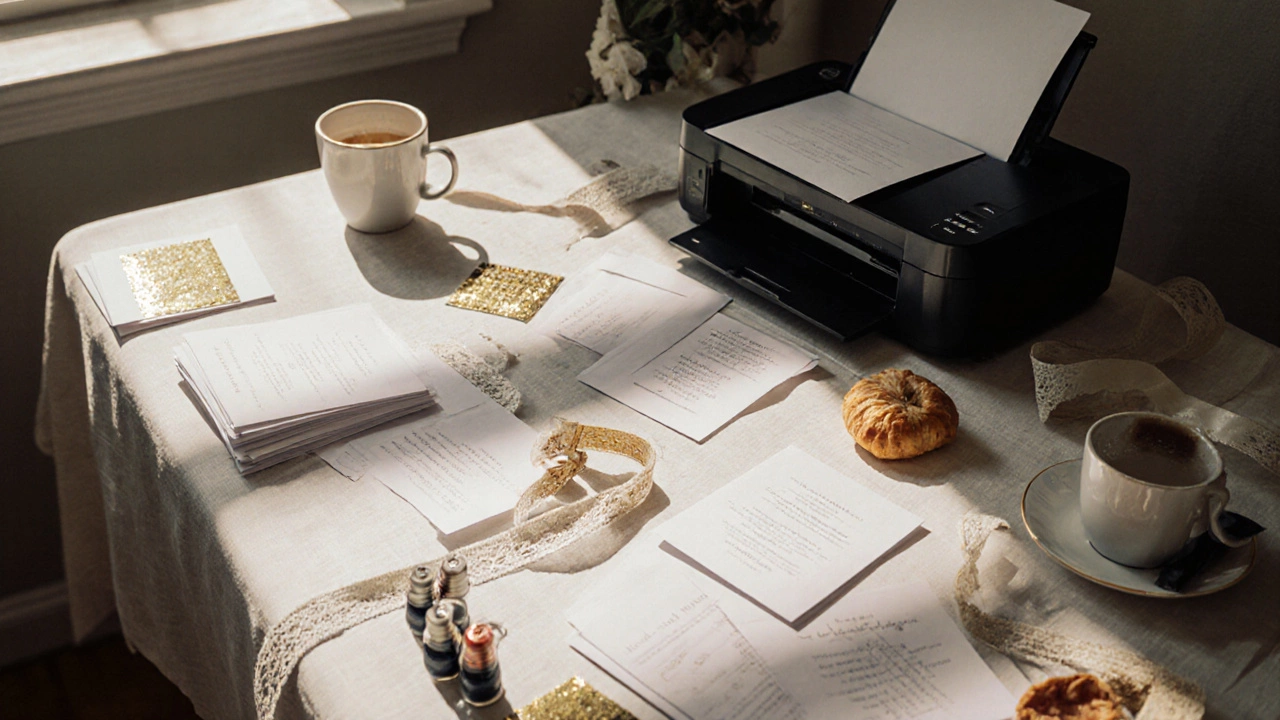Wedding Invitation Cost Calculator
Calculate whether it's cheaper to buy wedding invitations or make them yourself. Based on 2025 Australian costs and time value.
Your Inputs
Cost Breakdown
Pre-made Invitations
$180 - $350 for 100 invitations
(Includes printing, envelopes, basic design)
DIY Cost Estimate
$0 - $0
You could save $0 by DIYing
With your inputs, pre-made is still cheaper
Recommendation
Based on your inputs, buying pre-made invitations is recommended.
Your DIY time would cost more than the potential savings.
When you're planning a wedding, every dollar counts. And one of those small-but-surprising expenses? Wedding invitations. You might think printing your own at home is the obvious way to save money-but is it really? Let’s cut through the noise and look at what actually adds up when you compare buying pre-made invitations versus making them yourself.
What you’re really paying for
Buying wedding invitations isn’t just about the paper. You’re paying for design, printing quality, envelope lining, foil stamping, postage-ready sizing, and sometimes even assembly. A set of 100 standard printed invitations from a reputable online vendor like Minted, Zazzle, or Etsy sellers typically costs between $180 and $350. That’s $1.80 to $3.50 per invitation. Add on custom envelope addressing, wax seals, or RSVP cards, and you could easily hit $450.
Now, let’s say you want to make them yourself. At first glance, it looks cheaper. You buy cardstock, ink, a printer, some envelopes, and maybe a die-cut machine. But here’s where people get tripped up: the hidden time and material costs.
The DIY cost breakdown (real numbers)
Let’s break down what it actually costs to make 100 invitations from scratch, using real prices from Australian suppliers as of 2025:
- Cardstock (100 sheets, 300gsm, premium white): $35 (from Officeworks or Spotlight)
- Envelopes (100, C6 size, white): $28 (from Paper Source or local stationery shops)
- Printing ink (for 100 high-quality prints on thick paper): $40 (your printer uses more ink on heavy paper-you’ll go through 2-3 cartridges)
- Decorative elements (lace, ribbon, stickers, gold foil stickers): $50 (these add up fast if you want them to look polished)
- Die-cutting or scoring tool: $30 (if you don’t already own one)
- Envelope sealing (wax stamps or adhesive dots): $15
- Postage (for 100 invitations, Australia Post standard letter rate): $120 (if you’re using standard letter postage, not large envelope rates)
That’s $318 minimum. And that’s if you have a decent printer and don’t mess up any prints. If you ruin 10 sheets because the paper jams or the ink smudges? Add another $35. If you decide to upgrade to metallic ink or hand-lettered names? That’s another $50-$100.
Time isn’t free
Here’s the part no one talks about: time. Making 100 invitations isn’t a Saturday afternoon project. It’s a 20-30 hour job. That includes:
- Designing the layout (2-4 hours)
- Printing test sheets and adjusting settings (2 hours)
- Cutting, folding, and scoring each invite (15-20 hours)
- Attaching ribbon, foil, or embellishments (3-5 hours)
- Writing or printing addresses on envelopes (3-4 hours)
- Stamping and sorting (1-2 hours)
That’s over two full workweeks of evenings and weekends. If your time is worth $30/hour-which it is, even if you’re not getting paid for it-that’s $600-$900 in labor. Suddenly, the DIY option isn’t looking so cheap.

What buying gives you that you can’t replicate
Professional wedding invitation companies don’t just print-they engineer. Their paper is pre-tested for ink absorption. Their envelopes are sized perfectly for standard postage. Their fonts are kerned and aligned for readability. They’ve run hundreds of batches. They know how to prevent curling, bleeding, and misalignment.
And here’s something else: they handle bulk postage discounts. If you order 100+ invitations from a vendor like Paper Source or The Knot, they often include pre-paid postage or offer discounted bulk mailing rates. You can’t do that on your own unless you’re a registered business with Australia Post.
Also, think about errors. You spend 20 hours on these invitations. You realize halfway through that the date is wrong. You have to reprint 100 sheets. Now you’re out $70 in materials and another 10 hours. A professional vendor? They fix it for free and ship you a corrected set in 2-3 days.
When DIY actually saves money
There are cases where making your own invitations makes sense:
- You already own a high-quality printer and have extra ink and cardstock on hand
- You’re doing a very simple design-think plain white card with printed text, no embellishments
- You have a lot of free time and enjoy crafting
- You’re only inviting 30-40 people, not 100+
- You’re using digital RSVPs to skip physical response cards
For a small, casual wedding with 40 guests, DIY can drop your stationery cost to under $100. But for a traditional wedding with 80-120 guests, the savings vanish fast.
The middle ground: Hybrid options
You don’t have to go all-in on buying or making. Many couples use a hybrid approach:
- Buy pre-printed invitations from Etsy or Minted, then add your own ribbon or pressed flowers
- Print the text yourself on pre-cut cardstock from a vendor (they sell blanks for $0.50-$0.80 each)
- Use a digital RSVP link to skip the response card entirely
- Buy envelopes with pre-printed return addresses to save on handwriting
For example, buying 100 blank invitation cards for $0.60 each ($60 total), printing your text at home ($20 ink), and adding ribbon ($15) brings your cost to $95-far below the $300 you’d pay for fully printed and assembled invites.

What most couples end up choosing
Based on surveys from Australian wedding planners in 2025, 68% of couples who spent over $200 on invitations chose to buy them fully assembled. Only 12% made them entirely from scratch. The rest went hybrid.
Why? Because the stress of DIY isn’t worth the $50-$100 you *might* save. You’re already juggling venue bookings, catering, attire, and guest lists. Adding a 30-hour crafting project to that list? It’s not a cost-saving hack-it’s a burnout risk.
Final decision checklist
Before you pick up the glue gun, ask yourself:
- Do I have a printer that handles thick paper without jamming?
- Do I have time to spend 25+ hours on this before the RSVP deadline?
- Will I be happy if one invite smudges and I have to redo 100?
- Am I okay with looking slightly less polished than other weddings?
- Do I want to spend my wedding prep weekend gluing lace, not relaxing with my partner?
If you answered ‘no’ to more than two of those, buy them. You’ll thank yourself later.
Bottom line
Buying wedding invitations is almost always cheaper-when you factor in time, materials, and mistakes. DIY looks tempting on Pinterest, but the real cost is hidden in ink cartridges, ruined prints, and lost sleep. For most couples, spending $200-$350 on professionally made invitations isn’t a luxury. It’s a smart investment in your sanity.
Save your creativity for the reception decor or your first dance. Leave the invitations to the experts.
Can I print wedding invitations at home and save money?
You can, but you usually won’t save money. Printing at home uses a lot of ink on thick paper, and you’ll likely need to buy special cardstock, envelopes, and embellishments. For 100 invitations, expect to spend $250-$350 in materials alone-not counting your time or the cost of reprinting if something goes wrong.
How much do wedding invitations cost on average in Australia?
In 2025, the average cost for 100 printed wedding invitations in Australia is $220-$380. This includes design, printing, envelopes, and sometimes RSVP cards. Premium options with foil, letterpress, or custom illustrations can go up to $500.
Is it worth it to hire someone to hand-letter wedding invitations?
Only if it’s your priority and budget allows. Hand-lettering 100 envelopes can cost $150-$400 depending on the artist. It looks stunning but adds significant expense. Most couples opt for printed addresses or use a calligraphy service only for the main envelope.
Do I need to pay extra for postage on wedding invitations?
Yes. In Australia, standard wedding invitations that are heavier than 100g or larger than A6 size require a large letter stamp, which costs $1.20 each as of 2025. That’s $120 for 100 invites. Some vendors include this in their price; others don’t. Always check.
Can I use digital invitations to save money?
Absolutely. Digital invitations can cut your stationery costs by 80% or more. Platforms like Paperless Post, Canva, or Evenly let you send beautiful, customizable invites for free or under $50. They also include RSVP tracking and reminders. Many couples now use digital invites for most guests and send printed ones only to older relatives or close family.
